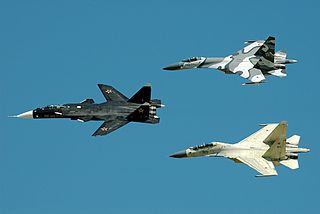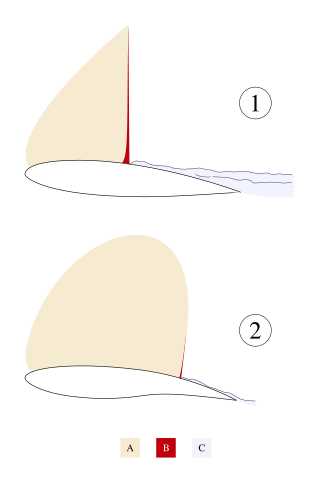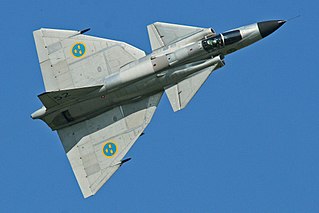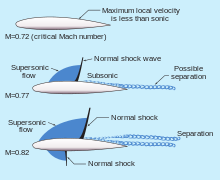
The Whitcomb area rule, named after NACA engineer Richard Whitcomb and also called the transonic area rule, is a design procedure used to reduce an aircraft's drag at transonic speeds which occur between about Mach 0.75 and 1.2. For supersonic speeds a different procedure called the supersonic area rule, developed by NACA aerodynamicist Robert Jones, is used.

A tailplane, also known as a horizontal stabiliser, is a small lifting surface located on the tail (empennage) behind the main lifting surfaces of a fixed-wing aircraft as well as other non-fixed-wing aircraft such as helicopters and gyroplanes. Not all fixed-wing aircraft have tailplanes. Canards, tailless and flying wing aircraft have no separate tailplane, while in V-tail aircraft the vertical stabiliser, rudder, and the tail-plane and elevator are combined to form two diagonal surfaces in a V layout.

A delta wing is a wing shaped in the form of a triangle. It is named for its similarity in shape to the Greek uppercase letter delta (Δ).

The sound barrier or sonic barrier is the large increase in aerodynamic drag and other undesirable effects experienced by an aircraft or other object when it approaches the speed of sound. When aircraft first approached the speed of sound, these effects were seen as constituting a barrier, making faster speeds very difficult or impossible. The term sound barrier is still sometimes used today to refer to aircraft approaching supersonic flight in this high drag regime. Flying faster than sound produces a sonic boom.

A swept wing is a wing angled either backward or occasionally forward from its root rather than perpendicular to the fuselage.

Transonic flow is air flowing around an object at a speed that generates regions of both subsonic and supersonic airflow around that object. The exact range of speeds depends on the object's critical Mach number, but transonic flow is seen at flight speeds close to the speed of sound, typically between Mach 0.8 and 1.2.
In aeronautics, wave drag is a component of the aerodynamic drag on aircraft wings and fuselage, propeller blade tips and projectiles moving at transonic and supersonic speeds, due to the presence of shock waves. Wave drag is independent of viscous effects, and tends to present itself as a sudden and dramatic increase in drag as the vehicle increases speed to the critical Mach number. It is the sudden and dramatic rise of wave drag that leads to the concept of a sound barrier.

Aircraft flight control surfaces are aerodynamic devices allowing a pilot to adjust and control the aircraft's flight attitude.

Hans Guido Mutke was a fighter pilot for the German Luftwaffe during World War II. He was born in Neisse, Upper Silesia.

Elevators are flight control surfaces, usually at the rear of an aircraft, which control the aircraft's pitch, and therefore the angle of attack and the lift of the wing. The elevators are usually hinged to the tailplane or horizontal stabilizer. They may be the only pitch control surface present, and are sometimes located at the front of the aircraft or integrated into a rear "all-moving tailplane", also called a slab elevator or stabilator.

A stabilator is a fully movable aircraft horizontal stabilizer. It serves the usual functions of longitudinal stability, control and stick force requirements otherwise performed by the separate parts of a conventional horizontal stabilizer and elevator. Apart from reduced drag, particularly at high Mach numbers, it is a useful device for changing the aircraft balance within wide limits, and for reducing stick forces.
Aircraft flight mechanics are relevant to fixed wing and rotary wing (helicopters) aircraft. An aeroplane, is defined in ICAO Document 9110 as, "a power-driven heavier than air aircraft, deriving its lift chiefly from aerodynamic reactions on surface which remain fixed under given conditions of flight".

In aerodynamics, the critical Mach number of an aircraft is the lowest Mach number at which the airflow over some point of the aircraft reaches the speed of sound, but does not exceed it. At the lower critical Mach number, airflow around the entire aircraft is subsonic. Supersonic aircraft such as the Concorde and combat aircraft also have an upper critical Mach number at which the airflow around the entire aircraft is supersonic.

A supercritical aerofoil is an airfoil designed primarily to delay the onset of wave drag in the transonic speed range.

An aircraft stabilizer is an aerodynamic surface, typically including one or more movable control surfaces, that provides longitudinal (pitch) and/or directional (yaw) stability and control. A stabilizer can feature a fixed or adjustable structure on which any movable control surfaces are hinged, or it can itself be a fully movable surface such as a stabilator. Depending on the context, "stabilizer" may sometimes describe only the front part of the overall surface.

In aerodynamics, pitch-up is an uncommanded nose-upwards rotation of an aircraft. It is an undesirable characteristic that has been observed mostly in experimental swept-wing aircraft at high subsonic Mach numbers or high angle of attack.

In aeronautics, a canard is a wing configuration in which a small forewing or foreplane is placed forward of the main wing of a fixed-wing aircraft or a weapon. The term "canard" may be used to describe the aircraft itself, the wing configuration, or the foreplane. Canard wings are also extensively used in guided missiles and smart bombs.

In aeronautics, a tailless aircraft is an aircraft with no other horizontal aerodynamic surface besides its main wing. It may still have a fuselage, vertical tail fin, and/or vertical rudder.
In flight dynamics, longitudinal stability is the stability of an aircraft in the longitudinal, or pitching, plane. This characteristic is important in determining whether an aircraft pilot will be able to control the aircraft in the pitching plane without requiring excessive attention or excessive strength.

Trim drag, denoted as Dm in the diagram, is the component of aerodynamic drag on an aircraft created by the flight control surfaces, mainly elevators and trimable horizontal stabilizers, when they are used to offset changes in pitching moment and centre of gravity during flight. For longitudinal stability in pitch and in speed, aircraft are designed in such a way that the centre of mass is forward of the neutral point. The nose-down pitching moment is compensated by the downward aerodynamic force on the elevator and the trimable horizontal stabilizer. This downwards force on the tailplane produces lift–induced drag in a similar way as the lift on the wing produces lift–induced drag. The changes (shifts) of the position of the centre of mass are often caused by fuel being burned off over the period of the flight, and require the aerodynamic trim force to be adjusted. Systems that actively pump fuel between separate fuel tanks in the aircraft can be used to offset this effect and reduce the trim drag.


















